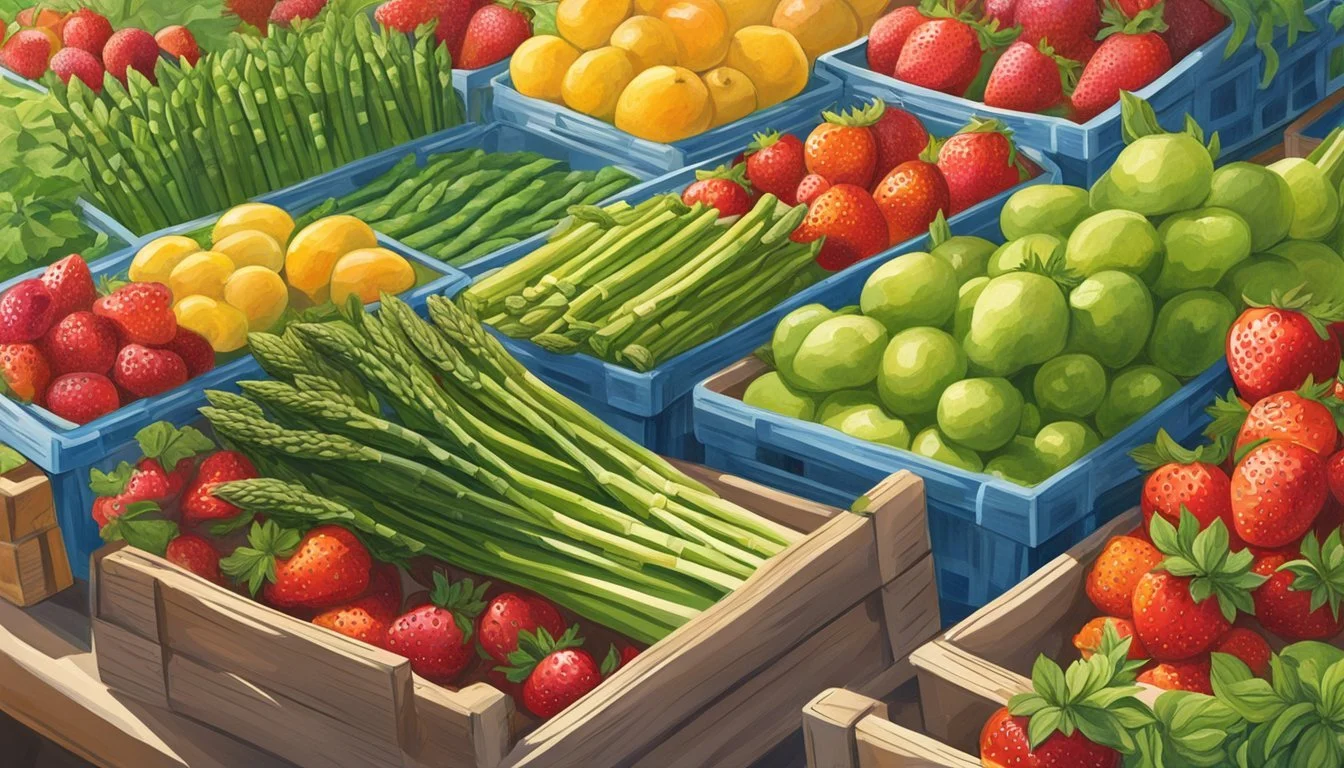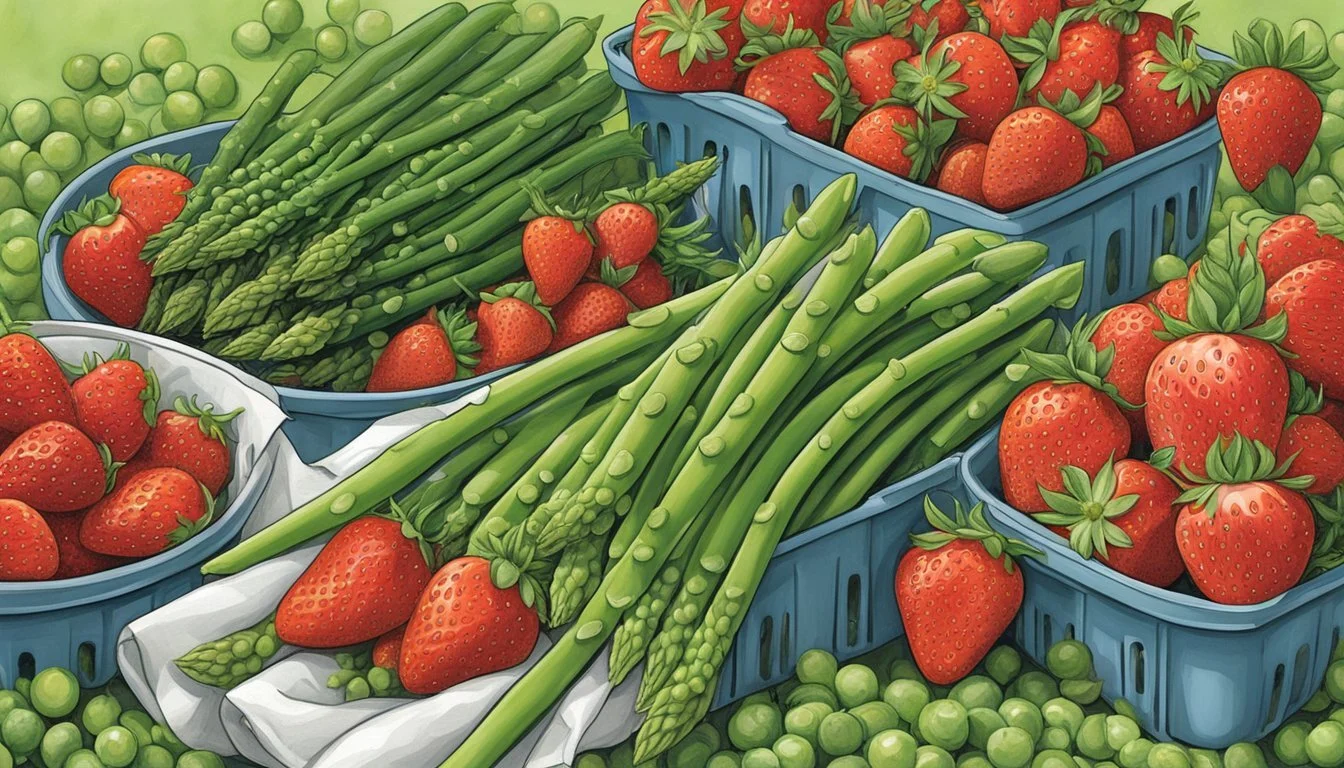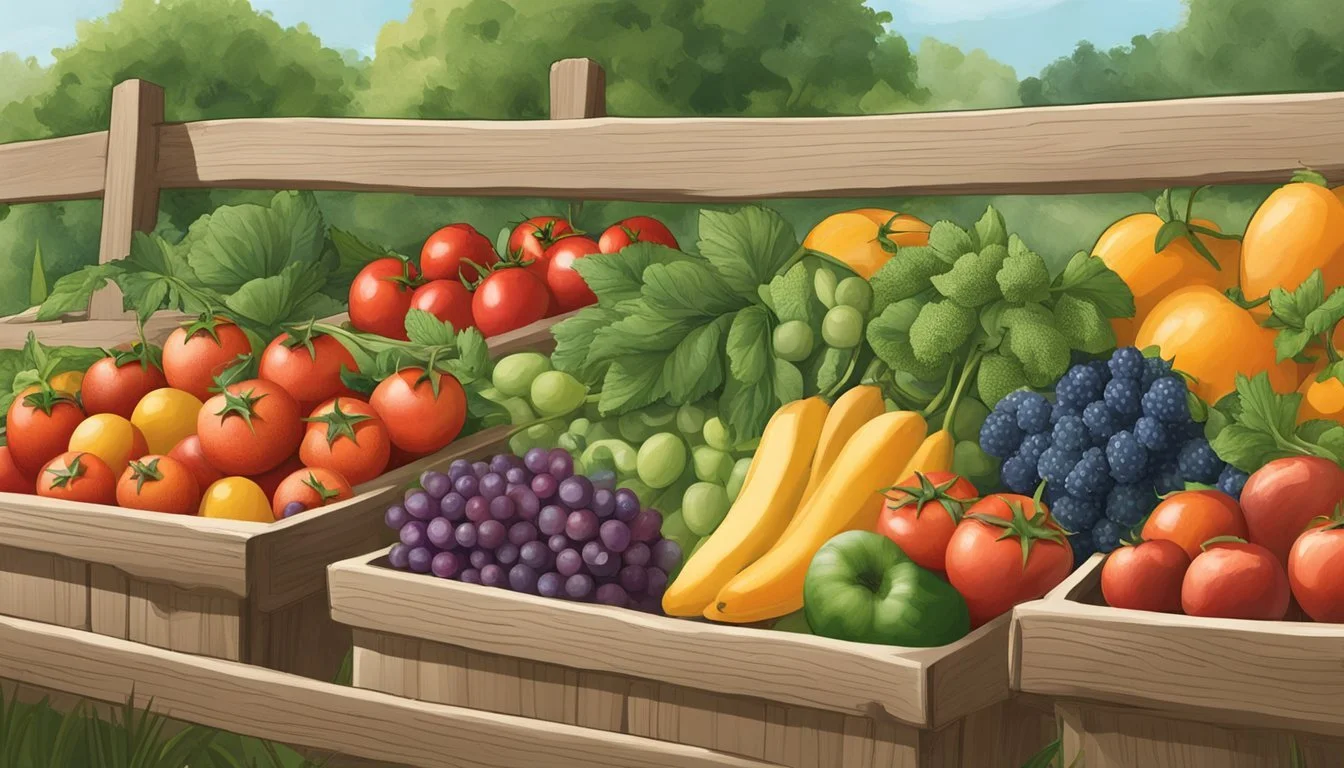South Carolina Seasonal Fruit & Vegetables in April
A Guide to Fresh Produce
This Article is Part of our South Carolina Seasonal Fruit & Veg Calendar
April in South Carolina marks a time of abundance for seasonal produce, signaling a shift in the growing season. As the state experiences a mild climate, it allows for an extensive variety of fruits and vegetables to be cultivated and harvested. This period is particularly favorable for farmers and consumers alike, as the land yields fresh, flavorful produce that captures the essence of the region.
The range of vegetables available during this month includes leafy greens such as collards, mustard greens, and turnips, which continue their presence from earlier months. Simultaneously, the advent of warmer weather brings forth new crops. Fruits, although not as diverse as vegetables during this early spring month, start to hint at the coming sweetness of summer, with strawberries often making their first appearance in the market.
Purchasing seasonal fruits and vegetables in April not only ensures peak freshness and taste but also supports South Carolina's local farms and economy. It fosters a connection between consumers and the natural growing cycles of their region, encouraging a sustainable approach to agriculture and consumption.
Overview of South Carolina's Climate and Agriculture
South Carolina's diverse climate and geography significantly influence its agricultural output. In particular, the state's capacity to harvest a variety of crops year-round.
The Impact of Climate on Crop Availability
The climate in South Carolina is characterized by its mild, humid conditions which play a crucial role in the availability of crops. Temperature variations, influenced by the Atlantic Ocean and regional patterns, contribute to a state that can produce an array of fruits and vegetables. The coastal areas, enjoying warmer temperatures ranging from the low-60s to Zone 9B conditions, enable an extended growing season for crops like strawberries and tomatoes, which begin to appear in local markets as early as April.
Precipitation, driven by the warm Gulf Stream, ensures that the state's farms receive sufficient rainfall, crucial for crops like peaches, a significant commodity for the local economy. Weather patterns, albeit sometimes unpredictable, are generally conducive to year-round planting and harvesting, supporting a robust agricultural sector.
Key Factors Influencing South Carolina's Growing Seasons
The state's growing seasons are shaped by several key factors:
Latitude: Located between 32 and 35 degrees North, South Carolina's latitude grants it a favorable growing temperate zone.
Proximity to Water Bodies: The nearness to the Atlantic Ocean ameliorates extremes of temperature, particularly along the coast, which benefits crops sensitive to frost.
Elevation: While much of the state sits under 1,000 feet in elevation, areas in the Upstate have colder temperatures and hardiness zones down to 7B, affecting when certain crops like apples and leafy greens can be sown and harvested.
The interplay between these geographic and climatic elements dictates the timing and variety of produce found in South Carolina's markets. As a result, the agricultural industry thrives, contributing significantly to the state's local economy by supplying fresh, seasonal produce to consumers and businesses alike.
Seasonal Harvest Calendar
In April, South Carolina's crop availability includes a variety of fruits and vegetables, signaling the transition from early spring harvests into the abundance of late spring produce.
Fruits in Season
Strawberries: Begin to ripen in April, marking the start of the berry season in South Carolina.
Vegetables in Season
Asparagus: (how long does asparagus last?) This early spring vegetable is typically ready for harvest in April.
Beets (how long do beets last?): Both the roots and the greens of beets are available during this month.
Broccoli: Continues to be available in April, offering a fresh crop for springtime recipes.
Carrots: Sown in late winter and early spring, carrots are harvested in April.
Greens: A variety of greens, including mustard greens and turnip greens, are typically harvested.
Lettuce: Various types of lettuce reach maturity for April harvests.
Radishes: Known for their quick growing cycle, radishes are ready for harvest.
Spinach: Cool weather favors spinach, making it a prime pick in April.
Benefits of Local Produce
Local produce in South Carolina offers an array of benefits ranging from enhanced nutritional content to supporting the local economy and reducing environmental impact.
Nutritional Advantages
Locally grown fruits and vegetables are typically fresher because they are harvested at peak ripeness. This not only contributes to a better taste but also means that the produce maintains more of its nutritional value. For example:
Bok Choy and Broccoli are rich in vitamins and can be found fresh in local markets during this period.
Leafy Greens like spinach contain iron and are at their nutritional best when freshly harvested.
Economic Benefits
When consumers choose to buy local produce, they directly contribute to the local economy. This support helps sustain farmers and creates jobs within the community. The benefits include:
Injection of money into the local economy, strengthening it.
Support of family farms, preserving local agriculture traditions.
Environmental Impact
Choosing local produce also implies a reduction in environmental impact. Since the food travels a shorter distance from farm to table, there is:
A decrease in greenhouse gas emissions from transportation.
A potential for less packaging and processing, lowering waste.
Featured Fruits and Vegetables in April
As spring continues to flourish in South Carolina, April brings a bounty of seasonal fruits and vegetables to the table. Locally grown produce such as strawberries and leafy greens are at their prime, providing both freshness and flavor.
Strawberries and Blueberries
The star fruits of April in South Carolina are strawberries, which typically begin to peak this month. Known for their vibrant red color and sweet taste, they are ideal for both eating fresh and adding to desserts. Blueberries, while not yet at their peak, start to become more widely available, hinting at the lush berry season ahead.
Strawberries: Begin to peak; vibrant and sweet.
Blueberries: Starting to become available; tangy and flavorful.
Leafy Greens and Herbs
April also witnesses a surge in leafy greens, which thrive in the moderate climate. Arugula (how long does arugula last?) and spinach are just a few examples of the greens that can be found in abundance. They are perfect for fresh salads and are packed with nutrients. Additionally, fresh herbs such as parsley begin to flourish, offering a burst of flavor to any dish.
Greens: Arugula, spinach available; nutrient-packed.
Herbs: Parsley and more; enhance flavor.
Root Vegetables and Tubers
Root vegetables like new potatoes and beets are harvested during this time, offering earthy flavors and versatility in springtime cooking. They can be roasted, mashed, or incorporated into hearty salads, and serve as a wonderful complement to the lighter fare of the season.
Root Vegetables: New potatoes, beets; earthy and versatile.
Selecting and Storing April Produce
When it comes to selecting and storing April produce in South Carolina, identifying the freshest options and following proper storage techniques are crucial. These practices ensure that the fruits and vegetables maintain their optimal taste and nutritional value.
Tips for Choosing the Best Quality
When picking April produce such as asparagus, beans, potatoes, and turnips, one should look for certain indicators of quality.
Asparagus should be firm, with tight, closed tips. The stalks should be straight and have a bright green color.
Beans must be firm to the touch and snappy; avoid any that are limp or have brown spots.
Potatoes should be firm, with smooth skins, free of sprouts, green areas, or blemishes.
Turnips are best selected when they are heavy for their size and have crisp, smooth skin.
It is important that individuals feel the texture and check the appearance of these vegetables to assess their freshness.
Storage Guidelines for Freshness
Each vegetable has its own storage requirements to maintain freshness:
Asparagus should be stored in the refrigerator, upright in a container with an inch of water, or wrapped in a damp paper towel and placed in a plastic bag.
Beans are best kept in a plastic bag in the refrigerator and should be used within a week.
Potatoes prefer a cool, dark place with good air circulation; avoid refrigeration as it can turn the starch into sugar.
Turnips can be kept in the refrigerator, in a plastic bag, to keep them crisp for up to two weeks.
Adhering to these guidelines helps prolong the life and freshness of April produce, ensuring that the vegetables retain their flavor and nutritional value until they’re ready to be enjoyed.
Cooking with Seasonal Produce
April in South Carolina brings an abundance of fresh fruits and vegetables perfect for enhancing your culinary repertoire. Utilizing seasonal and locally sourced produce guarantees peak flavor and freshness in your cooking.
Recipe Ideas for Spring Fruits and Vegetables
Strawberry Spinach Salad: Combine fresh spinach leaves with sliced strawberries, locally sourced goat cheese, and toasted pecans (how long do pecans last?). Dress with a balsamic reduction.
Spring Vegetable Stir-Fry (What Wine Pairs Perfectly With Vegetable Stir-Fry?): Sauté a mix of asparagus, snap peas, and young carrots with garlic and ginger. Serve over brown rice for a wholesome dish.
Cooking Techniques to Enhance Flavor
Roasting: Enhance the natural sugars in vegetables like asparagus and new potatoes by roasting them until they're caramelized and tender.
Grilling: For fruits like strawberries, grilling can intensify their flavor. Serve grilled strawberries with a drizzle of balsamic glaze for a fresh, vibrant dessert.
Finding Local South Carolina Produce
South Carolina boasts a diverse array of fresh produce available right from the source. Consumers have several dependable options for sourcing locally-grown fruits and vegetables, benefitting both their taste buds and the local economy.
Farmers Markets and Farm Stands
Farmers markets and farm stands are vital to the local food scene. For example, Columbia hosts a variety of markets where consumers can purchase seasonal items directly from growers. One can find fresh fruits like strawberries and leafy greens aplenty in April. These venues not only ensure fresh produce but also support local farmers.
Locations: Varied across cities and towns
Finds: Fresh fruits, vegetables, and other local products
Benefits: Supports the local economy, offers fresh seasonal produce
Fresh on the Menu Restaurants
Restaurants participating in the Fresh on the Menu program pledge to feature locally sourced ingredients. Diners in these establishments can taste the freshness of South Carolina-grown produce in their dishes. Such initiatives also strengthen the bond between local farmers and businesses, promoting sustainable dining.
Experience: Seasonal menus with fresh, local ingredients
Advantage: Encourages sustainable agricultural practices
Community Supported Agriculture (CSA)
Community Supported Agriculture (CSA) shares represent a seasonal subscription to a farm's produce harvest. Members receive a regular supply of fresh produce throughout the growing season. This model fosters a direct link between farmers and community members, enhancing the local food system's resilience.
Commitment: Season-long subscription
Reward: Regular allotment of fresh, local produce
Impact: Reinforces local food systems and economies
Each of these avenues provides a distinct means of enjoying South Carolina's bountiful produce while fostering a robust local agricultural community.







